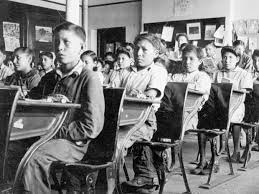To what extent should contemporary society respond to the legacies of historical globalization? Part B
To what extent should contemporary society respond to the legacies of historical globalization?
What are the governmental responses to addressing the lingering consequences?
Adapting programs and publications to Aboriginal needs is one type of governmental response. There are also expectations for more fundamental and lasting responses to issues that continue to linger after past imperialist practices and historical globalization. Indigenous groups have called for restitution, redress, and reconciliation from diverse levels of government. Examine the responses of governments in Aboriginal issues.

Read
Read about the residential school experiences and effects in “Contemporary Social Issues and Historical Imperialism” on pages 181 to 186 in Perspectives on Globalization. Examine the federal government’s response to the abuses associated with residential schools.
Responding to Residential Schools: Search for Healing
On May 10, 2006, the Government of Canada approved the Indian Residential Schools Settlement Agreement. This agreement included the following provisions:
-
A payment to every eligible former student living on May 30, 2005, and who resided at a recognized Indian Residential School: $10,000 for each former student plus an additional $3,000 for each year of residence past the first year
-
Payments not affecting social assistance payments and not subject to income tax
-
A Truth and Reconciliation Commission, mandated to promote public education and awareness about the Indian Residential School system and its legacy as well as to provide former students, their families, and communities opportunities to share their Indian Residential School experiences
-
Additional funding for events and memorials to commemorate the legacy of Indian Residential Schools
-
An additional endowment to the Aboriginal Healing Foundation to support its healing programs and initiatives for an additional five years
-
In total, $1.9 Billion for the direct benefit of former Indian Residential School students
| Our vision is one where those affected by the legacy of Physical Abuse and Sexual Abuse experienced in Residential School have addressed the effects of unresolved trauma in meaningful terms, have broken the cycle of abuse, and have enhanced their capacity as individuals, families, communities, and nations to sustain their well-being and that of future generations. Our mission is to encourage and support Aboriginal people in building and reinforcing sustainable healing processes that address the legacy of Physical Abuse and Sexual Abuse in the Residential School system, including inter-generational impacts. We see our role as facilitators in the healing process by helping Aboriginal people help themselves, by providing resources for healing initiatives, by promoting awareness of healing issues and needs, and by nurturing a supportive public environment. We also work to engage Canadians in this healing process by encouraging them to walk with us on the path of reconciliation. Aboriginal Healing Foundation |
Truth and Reconciliation CommissionIn order to begin the healing process The Indian Residential Schools Truth and Reconciliation Commission was established with a mandate of 5 years to act as an independent group to give former students of residential schools the ability to share their experiences.The Canadian commission was a little different than other commissions in other parts of the world because it was mainly concerned with experiences of children. Over a period of 100 years the commission focused on the legacies created by the imposition of the residential schools on First Nations people. The Truth and Reconciliation Commission of Canada wanted to create an atmosphere of reconciliation between Canada's Aboriginal and non-Aboriginal people to allow the country to move foward with strong partnership between its peoples. The process of the Commission used the United Nations Declaration on the Rights of Indigenous Peoples as its framework to guide reconciliation. In 2010, Canada announced that it accepted the United Nations Declaration on the Rights of Indigenous Peoples without qualification. As a result, the rights of First Nations, Inuit and Métis people to self-determination and constitutional rights must be recognized. To this end, healing began with apology and public truth sharing that would lead to acknowledgement of the harm that was done by the Residential Schools Program and move toward redressing those harms. This was conducted as a constructive process that would address the legacies of colonialism that were so destructive for Aboriginal peoples' cultures. During the 5 years of its mandate, the Truth and Reconciliation Commission gathered hundreds of first hand testimony from former students in Indian Residential Schools. These stories were recorded and made available for all Canadians as part of the Reconciliation process for Canada. You can access the full report by clicking on the following link. http://www.trc.ca/websites/trcinstitution/index.php?p=3
Video go here:
|
Reflect
How effective are these responses?
How successful are government responses to Aboriginal or Indigenous issues? Examine whether the quality of life, identities, or citizenship of Aboriginal peoples has improved with government support.
Since the days of the Crown acting on behalf of Aboriginal peoples in Canada, there has been some type of government action on the lives of First Nations, Métis, and Inuit peoples. Current governments have delegated resources to redressing the impacts of imperialism. The impacts of these responses on changing the lingering consequences of historical globalization are varied.